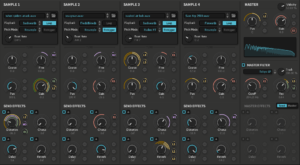
Reviewed by Joe Thom
Edited by Sam Hughes
Developer: Izotope
Reviewed on: PC
If you’re looking for a virtual instrument and sampler, with the flexibility of a modern synth, with the fun of spectral filtering, look no further!
The first iteration of Izotope’s Iris was famous for taking the advanced spectral editing technology of RX, and dumping it elegantly into a sampler / synthesizer. In Iris 2, Izotope have refined the interface, offered much more comprehensive modulation options, built upon the stock sample library and presets, and, perhaps most importantly, they’ve made it feel and play much more like an actual instrument.
Iris 2’s interface is sleek and functional. It’s been laid out perfectly to allow for the in-depth modulation system, with clearly defined areas for sample loading and editing, LFO and envelope parameters and master and send effects.

Interface & Spectral Editing
The sample editor area can be set to display all of the loaded samples at the same time, or individual layers for more precise editing. A selection of editing tools are available, many of which may seem familiar from graphics applications. Those who are accustomed to RX will also notice that the icons and spectrogram display are extremely similar.
Using these tools to paint freehand over almost any sample, be it a plucked instrument, a location ambience or a sampled synth, will almost certainly yield interesting results that would be virtually impossible to create through synthesis alone.
A nice feature of the interface is the separate “Mix” window. From this view it is possible to alter the playback (forward, reverse etc) and pitch modes of the individual samples. The available pitch modes include fixed, resample (similar to the resampling in a traditional sampler in that it simply plays the sample faster or slower) and Radius RT which will retain timing whilst altering pitch. Whilst the results of Radius RT are impressive, it does require a good chunk more CPU than the others. You can also set the root note of each sample (though this will be automatically detected upon loading a sample).

From the Mix view it is also possible to alter each sample’s pitch, pain, gain and send effects. With just a short period of experimentation in this window it is possible to create some incredibly interesting and complex results.
Subtractive Synthesis & Effects
Whilst you can achieve some pretty amazing things using the spectral editing tools alone, the subtractive synthesis section of Iris 2 is where the instrument really comes alive. With 17 filter models including two formant filters and selections of lowpass, highpass and bandpass filters, several of which are modelled on hardware, there is a great selection for subtle, or screaming, resonant filtering.
Even though the effects in Iris 2 are limited to Distortion, Chorus, Delay and Reverb, you most certainly won’t be left wanting. The distortion algorithms are borrowed directly from Izotope’s flagship distortion plugin – Trash 2 and offer subtle saturation to enormously overpowering fuzz.
Modulation
Last but certainly not least, the modulation. Each envelope and LFO is freely assignable to almost any synthesis or effect parameter, as well as to other envelopes and LFO’s. On top of this most of the synthesis and effect parameters will allow for up to three separate modulators to be applied, resulting in some tremendously deep sound design capabilities. What makes this even more extensive is the fact that the LFO’s feature 26 different waveform options. And possibly best of all, the modulation is applied with the use of an intuitive drag and drop system, reminiscent of Native Instruments Massive.
Conclusion
The only real drawback of Iris 2 is that if you currently use the first version and want to upgrade, any saved patches will not be compatible. This is largely due to the massively updated synthesis and modulation features, so a worthwhile trade-off in my opinion.
Iris 2 truly is a one of a kind soft synth which can be used to create beautiful musical patches or cater to a whole range of sound design needs.
LINKS
Official
We hope you enjoyed Joe’s review, check out others in our Reviews section. Don’t forget to sign up to our Monthly Newsletter to make sure you don’t miss out on our reviews and interviews.
We’re also running a Patreon campaign to make sure we can keep bringing you regular, high quality content if you’re feeling generous! Thanks for even sharing!
The Sound Architect




